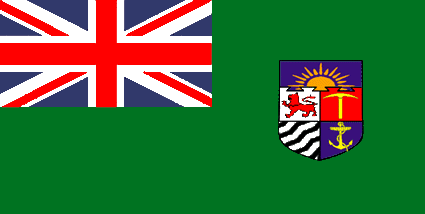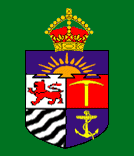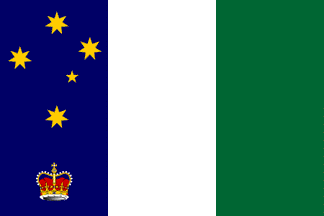
This page is part of © FOTW Flags Of The World website
South Africa : English Front for Liberty
Last modified: 2006-12-16 by bruce berry
Keywords: south africa | english front for liberty | southern cross | crown |
Links: FOTW homepage |
search |
disclaimer and copyright |
write us |
mirrors
 image by
Ben Castle, 23 Nov 2005
image by
Ben Castle, 23 Nov 2005
See also:
British African Front
The English African Front for Liberty, which was renamed the British
African Front, has closed down due to a lack of public support and due
to the conclusion by it's leader, Ben Castle, that such a
campaign was not going to achieve the freedom so yearned for.
The flag of the English African Front for Liberty has also changed.
(Please note all reference in this article to British is not to Great Britain or the British Isles but to the subjects of the British crown).
I discussed the "British African flag" as it has became known with
various authorities and organizations, as well as numerous
vexillologists, and there was been plenty of talk about what the ideal
flag should be. (Also affectionately called the 'rooinek banner').
The original British African flag was redesigned bearing in mind
suggestions of those interested. I couldn't please everyone, but have
managed to pull in a few key ideas. Indeed the new flag had its
foundation in the flag designs of Cecil John Rhodes himself.
The enormous Springbok Club, the growing Federation for Afrikaner
Development, the Rhodesian websites and the ex-British South Africa Police members have shown
support. A business woman has already expressed a desire to buy the new
flag design. The flag was also discussed on FlagTalk.
The new flag design is more accurate as an 'ensign'. It was
decided that the background be one colour, onto which the Union Flag and a crest be placed
to conform with the standard 'ensign pattern'. As previously, the flag of
the union is
the Union Jack, the symbol of the British monarch, and it sits in the
top left corner of the flag as was the case in British colonial African flags as well
as in the current Australia and New Zealand flags.
The background colour wasn't debated much and my unusual
choice of green was preferred. A basis for this colour can be found on
Cecil
Rhodes' Cape to Cairo flag, the only flag known to have been proposed
to represent all the British in Africa. The left half of that flag is the Egyptian flag, but the green on the right is felt to represent the
British in Africa. It also pleases those who have attachment to the
stripes of the Rhodesian flag. The green
background also makes the
flag stand out, and it is felt to be a colour that also represents many
African attributes, such as the bush and khaki.
 image by
Ben Castle, 25 Nov 2005
image by
Ben Castle, 25 Nov 2005
Then there was the issue of the crest.
Most states have an animal as an emblem, so I asked various people
want they felt would be an appropriate African animal that described the
British and the overwhelming response was the lion. The lion appeared on many British colonial African flags, and usually in red.
The red lion chosen for the British African flag is the same as that on the
Rhodesian coat of arms (which was taken from the arms of Cecil John Rhodes) as it is an easier symbol to draw than similar
lions that are found on other flags.
As most British colonial African flags featured crests, so too the British
African flag has to bear one. The shape of the crest comes of the Bermuda flag.
It was suggested that a pick-axe to represent the minerals that formed the
basis of the infrastructure and of wealth of many British
Africans be used. Therefore the yellow pickaxe was copied from the Rhodesian
Arms.
From the Rhodes Cape to Cairo flag comes the anchor. On that flag it
represented the Cape Colony, of which the infrastructure especially the core
at Cape Town, was built by sea trade. The importance of such trade is
recognized by symbols of ships on many British colonial African
crests.
The whole design was delayed by the unsettled issue of the floral emblem.
There are few such emblems on British colonial African flags. The
flame lily and the Protea are inappropriate as they are strongly
associated with other flags. The baobab tree was suggested, and there is also a
tree shown on the
British Central African flag. I eventually used a
sketch of this is uniquely African largest tree.
The sun at the top comes of the Northern Rhodesia flag. The colours on
the crest are rather meaningless individually, but represent Britannic
roots, as they come of the UK coat of arms.
The black and white stripes on the crest come
from the Federation of Rhodesia and Nyasaland flag, it
being almost a 'Dominion' similar to the Dominion of Canada or
the Commonwealth of Australia.
The conclusion was that as a sign of respect to the British monarch,
the British African flag crest must be shown either alongside the
Union Jack on the flag, or if not beside a Union Jack, it must be
under a crown resting on top.
Ben Castle, 23 Nov 2005 and 02 Dec 2005
English Front for Liberty
 image by Martin Grieve, 03 Oct 2004
image by Martin Grieve, 03 Oct 2004
The English Front for Liberty stands for the rights of English Africans (non-racist British descendants in Africa), who are sidelined
and ignored by the South African, Namibian and
Zimbabwean governments.
Details of the flag design can be found at: http://www.freewebs.com/englishafrican/flag.htm
The blue represents the English, the green for Africa, as in 'English-speaking
Africans'.
Green is commonly viewed as the colour representing Africa. The Bush is green,
as is the khaki, the bush hats, and so on. In Africa almost half
of what the eye sees is green.
Why Blue for the English?
The English speaking peoples can trace their roots back to England, and then from there to Denmark, the Netherlands and Germany. The English
language as we know it arose in Britain, and it is in Britain that many
English Africans roots are, even coloured English Africans. Therefore, English should be represented by a
colour of the British flag. That flag is the Union Jack. It is red and blue on a white canvas.
Do we take the red or the blue?
When Australian and New Zealand flags were made, blue was used as the background, whereas, USA and Cape had red. If you change the
star-covered blue square on the US flag for the Union Jack, you get the
US colonial flag.
Should we take the red, as the Cape did? No, in modern, not historic times, blue has a stronger connection with
English states, especially in the southern hemisphere. New Zealand and Australia have
blue backgrounds.
However, red, though used by Canada, is deeply entrenched in colonialism. The expression is 'the British painted half the world red', as on
British maps; Britain and any colony were painted red. Red is the colour
of a colony. English Africans have had various degrees of independence from Britain, since Natal gained self-rule. We oppose being a colony.
On the other hand, blue has no colonial meaning. In addition, it was found on the
old
South African flag. That was the flag of a Anglo-Afrikaner federation, and did not represent
the original Khoi/San inhabitants or 'blacks'. A new equal flag has be made, but the
colours of that old flag still represent the English and Afrikaners. The colours where blue and orange stripes,
with small British and Dutch flags between. If one of the small flags
represents each group, perhaps a colour represents each group.
If the Afrikaners have taken the green for Africa alongside the orange of the old
South African flag, that is acceptable.
Ben Castle, 17 June 2004
 image by
Ben Castle, 25 Nov 2005
image by
Ben Castle, 25 Nov 2005
 image by
Ben Castle, 23 Nov 2005
image by
Ben Castle, 23 Nov 2005